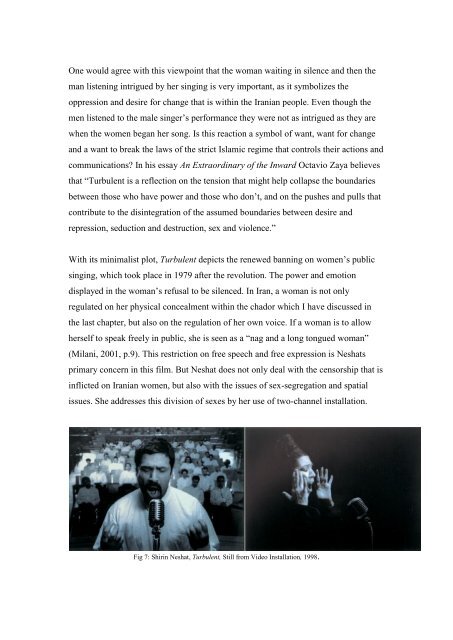A Gaze through the Veil:
A Gaze through the Veil:
A Gaze through the Veil:
Create successful ePaper yourself
Turn your PDF publications into a flip-book with our unique Google optimized e-Paper software.
One would agree with this viewpoint that <strong>the</strong> woman waiting in silence and <strong>the</strong>n <strong>the</strong>man listening intrigued by her singing is very important, as it symbolizes <strong>the</strong>oppression and desire for change that is within <strong>the</strong> Iranian people. Even though <strong>the</strong>men listened to <strong>the</strong> male singer’s performance <strong>the</strong>y were not as intrigued as <strong>the</strong>y arewhen <strong>the</strong> women began her song. Is this reaction a symbol of want, want for changeand a want to break <strong>the</strong> laws of <strong>the</strong> strict Islamic regime that controls <strong>the</strong>ir actions andcommunications? In his essay An Extraordinary of <strong>the</strong> Inward Octavio Zaya believesthat “Turbulent is a reflection on <strong>the</strong> tension that might help collapse <strong>the</strong> boundariesbetween those who have power and those who don’t, and on <strong>the</strong> pushes and pulls thatcontribute to <strong>the</strong> disintegration of <strong>the</strong> assumed boundaries between desire andrepression, seduction and destruction, sex and violence.”With its minimalist plot, Turbulent depicts <strong>the</strong> renewed banning on women’s publicsinging, which took place in 1979 after <strong>the</strong> revolution. The power and emotiondisplayed in <strong>the</strong> woman’s refusal to be silenced. In Iran, a woman is not onlyregulated on her physical concealment within <strong>the</strong> chador which I have discussed in<strong>the</strong> last chapter, but also on <strong>the</strong> regulation of her own voice. If a woman is to allowherself to speak freely in public, she is seen as a “nag and a long tongued woman”(Milani, 2001, p.9). This restriction on free speech and free expression is Neshatsprimary concern in this film. But Neshat does not only deal with <strong>the</strong> censorship that isinflicted on Iranian women, but also with <strong>the</strong> issues of sex-segregation and spatialissues. She addresses this division of sexes by her use of two-channel installation.Fig 7: Shirin Neshat, Turbulent, Still from Video Installation, 1998.




